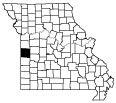Missouri Courthouses
Contact and other information about this county is available on the National Association of Counties website.
Editor’s note
The PDF version of this publication includes illustrations. Select the “Download this publication” button.
 County: Bates
County: Bates
Organized: Jan. 29, 1841
Named after: Frederick Bates, second governor of Missouri
County seat: Butler
Missionaries from New York settled the first community in Bates County, Harmony Mission, for the purpose of educating Indians. When Bates County organized and separated from Cass County in 1841, county commissioners selected Harmony Mission as the first county seat, presumably because of the established development and central location.
After first meeting in a private home, subsequent courts met in the Mission House until 1847 when the county seat moved to Papinville, three miles southeast of Harmony Mission.
Orders for building the first courthouse, at Papinville, came in November 1852, when the court appointed Freeman Barrows superintendent and appropriated $2,500. The following month Barrows submitted a plan and the court accepted bids. But, in August 1853 Abraham Redfield replaced Barrows as superintendent and produced plans and specifications prepared by Fritzpatrick and Hurt from Benton County. (Fritzpatrick's name also appears as Fitzpatrick.) The court appropriated $4,200 for the 35-by-60-foot brick building. It was completed in 1855. After 1856, when the county seat moved to Butler, Philip Zeal brought the courthouse and converted it to business use. Destruction by fire came in 1861, during the Civil War.
In 1855, after an area separated to become Vernon County, Papinville was no longer near the geographic center of Bates County. The original plan for dividing Butler's land into building lots, commonly called a plat, was filed and recorded in August 1853. Fifty-five acres donated to the county induced officials to move the county seat to Butler in 1856. The court ordered a 50-by-50-foot brick courthouse at an estimated cost of $5,000. Fritzpatrick and Hurt again served as contractors. This building, too, burned in 1861.
During the Civil War courts were held in locations other than the county seat. In May 1864 the court met at Johnstown. The legislature recognized Pleasant Gap as the official county seat in 1865, and the sheriff was ordered to prepare a clerk's office and courtroom.
At the end of the Civil War, Bates County citizens returned to a devastated county seat. At the November 1865 term, the court appropriated $750 for a clerk's office and courthouse. The courthouse was to measure 16 by 24 feet, the clerk's office 16 feet square, and both 10 feet high. Later appropriations raised the sum to $1,100. John D. Meyers, county clerk, served as superintendent, and the court authorized him to select the site for this interim courthouse. Old settlers recalled the frame building situated in the northeast corner of the square.
After several attempts, plans for the 1869 courthouse crystallized (Figure 1). Plans of architect P.B. Leach and specifications submitted by Samuel Ward were adopted. In April 1869 the court awarded the building contract to J.B. Linkenpaugh for $23,000. Cornerstone ceremonies, held on July 15, 1869, were reported in the History.
Figure 1
Bates County Courthouse, 1869-1899. Architect: P.B. Leach (Courtesy: State Historical Society of Missouri)
This 75-foot-square brick building, in the center of the 300-foot public square, had five rooms on the first floor, three on the second and two large rooms on the third floor, leased by local civic or fraternal organizations. In 1899, after being declared unsafe, the building was sold for $500 to the highest bidder, J.S. Francisco.
The court moved into new quarters in January 1900. A successful election for $40,000 in bonds was supplemented by $10,000 from general funds. This provided $50,000 for a new courthouse. George McDonald was chosen architect for the 80-by-105-foot building (Figure 2). The courthouse of 1901 is similar to three other Missouri 19th century courthouses by the same architect: Andrew County, 1899; Johnson County, 1896; and Lawrence County, 1900. Contractors for this building, which was built with Carthage stone, were Bartlett and Kling, Galesburg, Illinois. Excavation began during July 1901; the cornerstone was laid Oct. 10, 1901 (Figure 3), and the court accepted the completed building, which is still in use as the Bates County Courthouse, in July 1902.
Figure 2
Bates County Courthouse, 1901-, Architect: George McDonald (Courtesy: State Historical Society of Missouri)
Figure 3
Cornerstone ceremony Oct. 10, 1901. (From: Butler, Missouri Centennial 1856-1956)
Bibliography
Books
- Atkeson, W.O. History of Bates County. Topeka: Historical Publishing Company, 1918.
- Butler, Missouri Centennial 1856-1956.
- History of Cass and Bates Counties. St. Joseph: National Historical Company, 1883.
- Resources and Attractions of Bates County, Missouri. 1894.
- The Old Settlers History of Bates County, Missouri. Amsterdam, Missouri, 1897.
Newspapers
- Bates County Democrat, Sept. 25, 1969.
- Bates County Record, Jan. 6, 13, 27, Feb. 3, March 3, 10, 17, 24, 1900; Feb. 16, March 2, Oct. 12, 1901.
- Butler Weekly Times, Feb. 22, 1888.
Manuscript collections
- Work Projects Administration, Historical Records Survey, Missouri 1935-1942 Bates County. Located in Joint Collection: MU, Western Historical Manuscript Collection-Columbia and State Historical Society of Missouri Manuscripts.